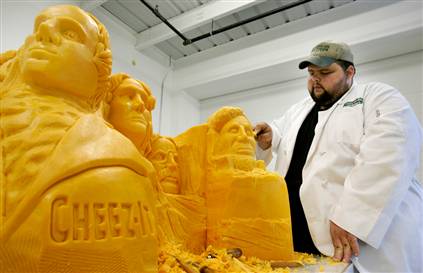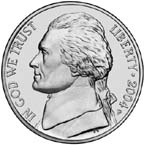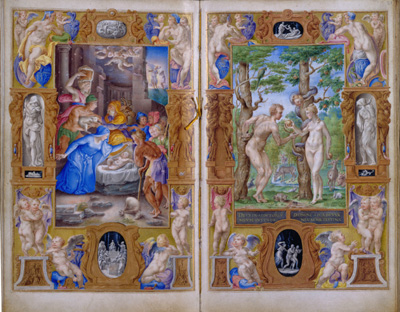“The history of the world is the discipline of the uncontrolled natural will, bringing it into obedience to a universal principle and conferring subjective freedom.” — Hegel
“Progress might have been alright once but it has gone on too long.” — Ogden Nash
(To quiet complaints about the last long post, I’ve broke this one into smaller sections, each with a heading. I hope it “feels” like several small, acceptable posts, even if it is really one large, unacceptable post.)
THE ORIGINAL AMERICAN CHEESE
As far as I know, none of the Native Americans were cheesemaking people. They had other things to do; so there are no “ancient” American cheeses. And nobody’s suggested to me that pilgrim cheesemakers, colonial cheesemakers, or settler cheesemakers felt compelled to creatively experiment with their medium, not for the better, at least. Cheeses and recipes were brought from overseas, and cheeses were made at home, sold in smalltime markets. Cheddar was the big thing. It seems to have been a practical cheese, then as now: manageable despite the volatile New England climate, which defeated most cheeses. By 1790 American cheddars were exported back to England, the original motherland of the breed (which is not so much named after the town of Cheddar as the Cheddar Gorge, a tourist attraction since the 18th century that gathered hungry crowds and popularized the local cheese). Before the curious single-serving packets now called “American Cheese,” Brits called imported U.S. cheddar “American cheese,” or “Yankee cheese.” Americans called it “yellow cheese” and “store cheese,” sometimes “applepie cheese.”
The Brits looked down on Yankee cheese. But Americans were doing their best, probably; and sometimes they even felt pride in their yellow cheese. For example: the people of Cheshire Massachusetts once made a 1235-pound, 4-foot by 15-inch cheddar and gave it to President Thomas Jefferson, for inspiration I suppose. That was in 1802. They inscribed on the rind one of Jefferson’s famous slogans: “Rebellion to tyrants is obedience to God.” They wrote that on a cheese. The pastor that orchestrated the Mammoth Cheese‘s creation, Elder John Leland, assured Jefferson that none of the milk was made by any slaves, or Federalists — since this cheese was also a political gesture. Leland thought it was the best damn cheese ever made. I imagine Jefferson was nonplussed.
(Andrew Jackson was awarded a cheese to match Jefferson’s in 1845. The cheesemakers wanted to assert that Jackson deserved Jefferson’s “every honor” and more — even cheese honors. [For more on White House cheeses, look here.] And in 1890 a couple of British villages made a 1250-pound, 9-foot-diameter cheddar and gave it to Queen Victoria, who no doubt envied Jefferson’s cheese as much as Jackson did.)
Some claim that Jefferson, thanks to Cheshire’s brief madness, was the first man of authority dubbed The Big Cheese. Another authority suggests that the phrase comes first from the Persian or Urdu word chiz, for “thing,” which the English picked up in India. The imperialists started calling things cheeses, with a positive connotation; so by 1890 they were calling big things big cheeses. Jefferson was indeed a big thing in his day; but he may have been a little early for the epithet.
IMPERIAL SNOBBERY AND AMERICAN IMPATIENCE
Google Books found me an issue of the British Penny Magazine of the Society for the Diffusion of Useful Knowledge from March 12, 1842, which features an article on “American Cheese” of the time. It contains, not surprisingly, some useful knowledge on the subject. Here’s an excerpt:
“The characteristics of American cheeses consist in their greater diameter or breadth in proportion to their thickness; in their possessing their natural colour, little or no artificial colouring being employed; in their being full of holes or eyes; in possessing a pungent or rather bitter taste, and in a bandage of linen or cotton cloth being passed round their outward rim. In some matters the Americans have adopted modes and customs different from ours and from those of other countries, and by no means superior to those they have rejected or altered. [I do appreciate the passive aggressive condescension of that deliberately overgeneral sentence.] Cheese-making may be considered one of those; and, as a consequence, they produce a quality of cheese decidedly inferior to our own.”
The author also blames American inferiority on a climate too extreme for cheese, and on misplaced priorities that valued salt and, above all, speed (in coagulation, curd breaking, and pressing) over finished quality.
THE YANKS CHANGE CHEESE FOREVER
So maybe Americans didn’t successfully innovate or stake out a cultural niche with cheese, until later — until 1851, when Jesse Williams established the America’s first cheese factory in New York — possibly the first “modern”/industrial cheese factory in the world. (Arguably, cooperative American systems were already practiced in other areas — in 1841, for instance, after the People of Wisconsin “had arrived at that point of refinement when they longed for cheese” and banded together to serve that cause [see Pickett] . But Jesse Williams gets the credit and none of us have the time to research and debate it.) Jesse Williams’ father was a famously good cheesemaker, but fate had condemned young Jesse to meager talent in the trade. Jesse was living under a shadow, shaming his maker; so he conceived the cheese factory as a means of still collaborating in business with his father. Which is touching. There is Disney-movie potential in this story. With his factory, Jesse was able to buy up milk from many local dairy herds, mix it all together with his own and his father’s, and churn out extra-large cheeses that were more uniform, consistent, and economic. Of course his factory made cheddar. It changed everything.
THE FALL AND REDEMPTION OF MAN, REPLAY
From there, today’s Standard American Cheese Tale, as culled from glossy books and internet sites, goes like this: America’s main cheesemaking-innovation was mass production, efficiency: Williams’ factory-style cheese. The States were the vanguard of the Great Industrialization that then swept Europe, and with the help of two World Wars crippled, bludgeoned, all but garroted traditional cheesemaking culture — in part, for a time. During the Dark Ages of American Prosperity the Forces of Darkness strengthened their grip on the cheesesoul of the people; Americans were eating plastic scraps and used car parts and calling it food; given a few more decades they would have gladly consumed raw cancer boiled in turpentine, if nothing stopped them . . . culture and decency rotted and ruined, the human spirit severed from its source . . . Until 60s counterculture at last declared everything like that wrong, evil, Mammon- or Moloch-ish. And then those movements promoting organic, local, sustainable food began gathering their followings. 80s affluence encouraged creative-types to buy farms and experiment, the fervor caught on; and so it is that now we have a fabulous artisanal cheese culture coming into its own. It’s up to our generation to spread the good news and carry on the work.
Yes, it’s a suspiciously messianic tale that twists some undeniable truths, and so standardized that the discriminating cynic must suspect it’s some large fraction myth — but I don’t know right now, and I won’t take a stand on it — maybe later — I’m not here now to take stands — I’m unsure what I’m here to do — I was supposed to write about Grayson still. And I will, but I was sidetracked. So:
Next time on “After Cheese Comes Nothing”: Posts on St. Hildegard, Taleggio, and American cheesemaking culminate in a single anticlimactic post on Grayson, an artisanal American washed-rind cheese from Virginia.




A 1235-pound, 4-foot by 15-inch cheddar would UNDOUBTEDLY inspire me. Be informed.
“Rebellion to tyrants is obedience to God.” – The revolution will not be televised!
Thanks for teaching me the word “nonplus”.
You write well! No other website teaches me as much about American cheese as yours and I have read you on and off for ages now. In order to remember you and to allow others to share my good fortune in finding you, I have just put you on my favourites roll.
Thanks for your site.
Please tell me something – what happens to all that cheese???